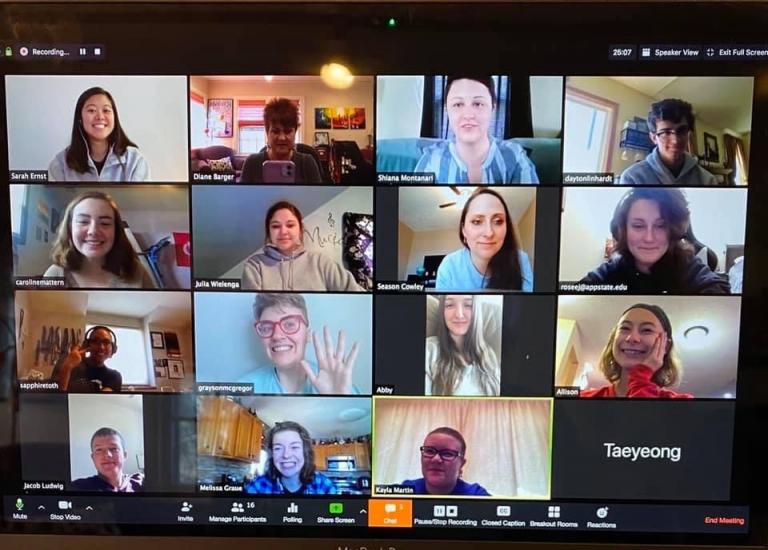
Of course, in this new reality that we are all facing, the way instruction is being delivered at Glenn Korff School of Music, especially in regard to private lessons, has changed. With one-on-one, in-person lessons impossible, the shift is being made to the online environment.
We asked our instructors how they are going about making that switch. Here are a few examples:
Hixson-Lied Professor of Piano Mark Clinton: I’ve got 15 applied students for the next five weeks. The day before their scheduled lesson, they record a “performance” just like they would sit down and play for me at the beginning of a normal face-to-face lesson. I can then evaluate things and have a plan of action for the remote lesson the next day. It’s a lot easier this way because I can’t stop them as easily when they’re playing due the limitations of the technology. I’m still meeting all of my applied students at their regularly scheduled lesson times via Zoom.
Marguerite Scribante Professor of Music, Piano Paul Barnes: I’m actually quite excited about my first Zoom studio class. Because we’re online, I have the ability to invite lots of former students to participate. One of these, Allessandro Conti, lives in Rome and will be able to give us all an update on the situation in Rome. I think this has great potential to stay connected to both past and future students! I’ve invited all of my prospective students as well.
Professor of Voice Donna Harler: I'm in the process of recording accompaniments to my students' repertoire and sending them SLOWLY to each of them. I hope they all sing to them! It has been scientifically proven that the act of singing raises serotonin levels!
Professor of Clarinet Diane Barger: I have my home studio set up to do lessons via Zoom with my laptop and an Apoggee microphone; if that is not a great platform for some students, I also have GoogleDuo, FaceTime or Skype set up. I have asked my students to scan the music for their lessons each week (using CamScanner or a similarly free app they can use) that they will email me the day before their scheduled lesson. That way I can view their music on my iPad Pro during their lesson and make reference to particular measures, etc. I have already enjoyed a Zoom meeting with my students (who could attend) last week to discuss how we were going to do lessons the rest of the semester; I also recorded the session on Zoom and posted the video on our UNL Spring Clarinet Studio private Facebook group so students who could not attend could view the meeting. Those who had yet to present their lecture about their selected famous clarinetist in studio class will be recording their presentation (with Power Point) via UNL’s VidGrid, which allows them to easily record on their laptop and then save the file with a link to their video via VidGrid; they will then post that link to our private Facebook studio group for all to enjoy (and email their handouts to the studio, as well), as we no longer have studio class the rest of this semester.
Professor of Music, Trombone Scott Anderson: The coronavirus epidemic has put all of the faculty into the online mode of teaching. I don't know if there is a more challenging area to teach remotely than applied lessons. It's occasionally done, but rarely with the sonic outcomes we would like. With that in mind, I chose to teach out of the sound isolated practice room in my basement. I am a trombonist, so the question of why I have this booth is self-explanatory. As to style, there are a couple of approaches that the faculty have studied. They are both valid and present challenges while solving problems. The two choices are synchronous and asynchronous teaching. Asynchronous teaching allows the professor to assign lesson materials to the student and have the student record and upload the video. There are positives to this methodology. First, the student has control over the recording process and second, they are not dependent on internet speed or bandwidth to make or break the lesson. I have chosen the synchronous option. I am using FaceTime, Skype and in some cases Zoom to teach my lessons for the remainder of the semester. The advantages of this method include a spontaneous dialogue with the student as they play. I can also make observations on the physical aspects of their performance in real-time. You will notice in the pictures that I am using an external microphone and headphones while I teach. The trombone is an acoustically large instrument and the sound needs to be controllable. The headphones prevent feedback and allow me and the student to hear more clearly. I am also using a small USB mixer/interface to run the microphone and control sound levels. I have used this setup for many distance lessons with recruits and it works well. Nothing will replace in-person lessons, but during challenging circumstances, this is an option.
Assistant Professor of Bassoon and Music Theory Nathan Koch: I’m having students upload recordings of their playing assignments, I’ll be providing written feedback by marking up PDFs of the score & sending it to the student before their next Zoom lesson. We are also reading and summarizing a variety of short articles related to pedagogy, playing, and reedmaking, and the students are also recording short duets and basso continuo parts with themselves.
Be sure to follow along our website and social media channels for all of our updates as well as videos from our faculty and students.
--Brian Reetz, Glenn Korff School of Music